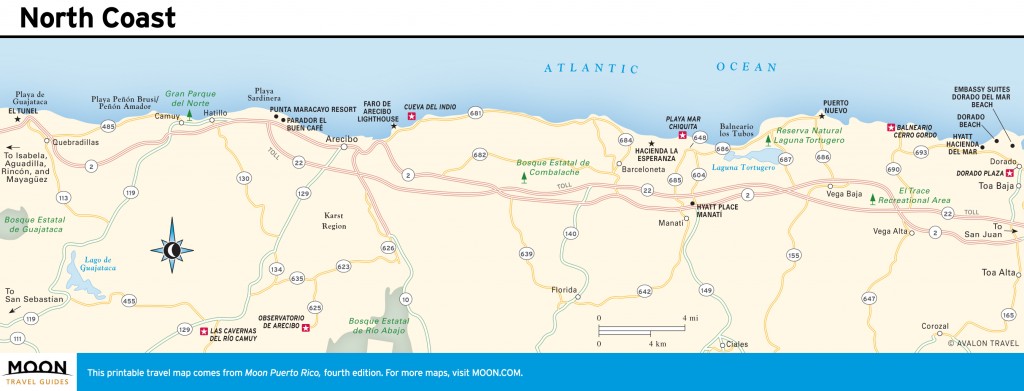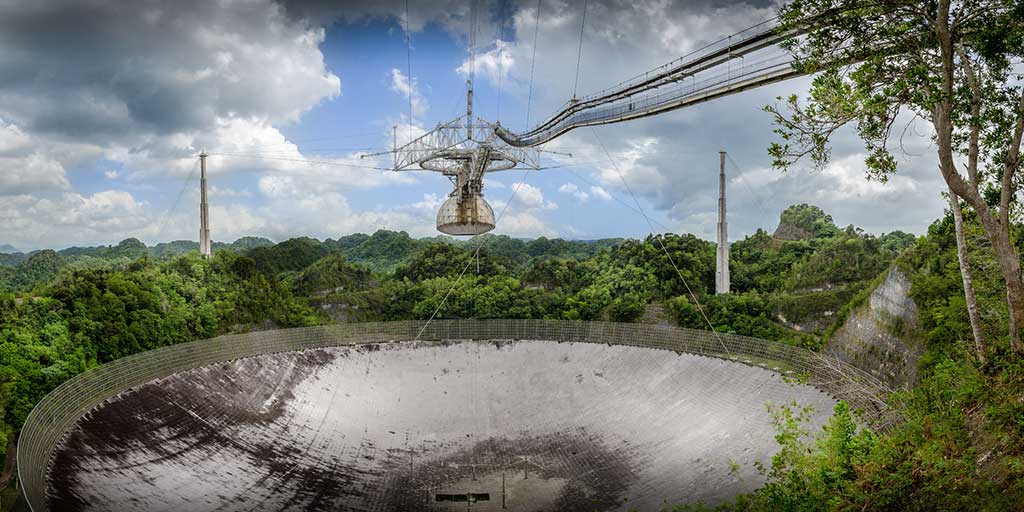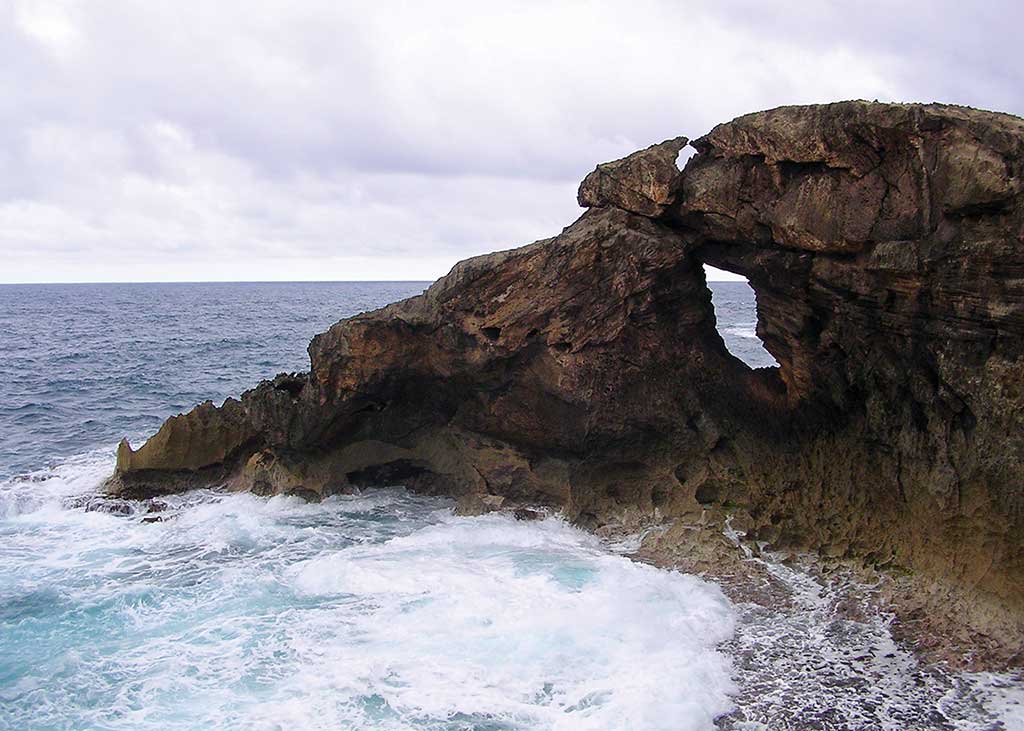Before the Spanish arrived, Arecibo was home to a peaceful group of about 200 Taíno natives led by Cacique Arasibo, reputed to be a fair ruler over his village of fishermen. In 1515, Spain claimed the Arecibo area and enslaved the Taíno, most of whom died shortly thereafter. Today Arecibo is the most populated municipality on the north coast, with more than 100,000 residents who call it home. It is also a major industrial hub, producing textiles, chemicals, electronics, and medical instruments. As a result, Arecibo has been blighted by massive urban sprawl distinguished by traffic-clogged thoroughfares and unfettered commercial development.
As you climb ever higher toward the observatory, the first glimpse between treetops of the telescope’s suspension apparatus is a startling sight.Nevertheless, there are several good reasons to visit the municipality of Arecibo. In the mountainous karst country south of town is the world-famous Observatorio de Arecibo. On the coast is Cueva del Indio, a geographic wonder that illustrates what happens when crashing waves meet massive petrified sand dunes—it’s also a natural repository for petroglyphs. And for children, there’s the Faro de Arecibo Lighthouse and Historical Park with its themed playgrounds and welcoming patch of beach.
North Coast
You know you’re headed someplace unique as you travel south from the town of Arecibo toward the Observatorio de Arecibo (end of Carr. 625, 787/878-2612, daily 9am-4pm June 1-July 31 and Dec. 15-Jan. 15; Wed.-Sun. and Mon. holidays 9am-4pm rest of the year, $10 adults, $6 children and seniors), the world’s largest and most sensitive radio telescope. The bustle of commerce, industry, expressways, and road-construction projects eventually gives way to a bright green grassy landscape dotted with dramatic haystack-shaped hills called mogotes. Passing cars become few as the curvy road winds around the hills and ever upward, past sprawling cattle farms and errant chickens.
Be sure to bring sturdy walking shoes. Entry to the observatory requires a half-mile hike—mostly up stairs—from the parking lot to the entrance, and there’s little shelter along the way. As you climb ever higher toward the observatory, the first glimpse between treetops of the telescope’s suspension apparatus is a startling sight. Its cold, clinical, metal construction is in sharp contrast to the wilderness that surrounds it. The road ends at a guardhouse, where you park your car and begin the long uphill trek on a concrete surface to the top of the massive sinkhole that contains the telescope’s dish. Visitors unable to make the journey by foot can get permission from the guard to drive up to the entrance.

Arecibo Observatory. Photo © Frank Van Den Eijnden/123rf.
Because there’s not really much to do on a tour of the observatory, other than gawk at the sheer size of the telescope dish, a modern education center was opened in 1997. Inside are two levels of informative displays and interactive exhibits that educate visitors on the finer points of the study of space and the atmosphere. A short film on the telescope is screened throughout the day in both English and Spanish. But the highlight of the center is its observation deck, from which visitors can peer over the side of the massive dish. There’s also a gift shop that sells all kinds of great educational books, models, and toys. It’s a good source for maps of the island too.
Because it’s located on private property and not technically an official tourist site—no government-sanctioned bathrooms, marked trails, information center, and so on—Cueva del Indio (Carr. 681, km 7, parking $2) is one of Arecibo’s lesser-known attractions, but it’s well worth investigating. A hand-painted sign marks the turn that takes visitors to a parking lot where someone will collect your money and point you toward the caves. After a short trek through scrubby, prickly brush, the topography gives way to what looks like a massive moonscape rising out of the sea. It’s a huge coral outcropping that has been carved out and shaped over time from the pounding sea beating against its base. To the west is a large hole in the surface that leads down into a cave, which bottoms out on the sea floor. On its interior walls are faint petroglyphs—a sun, an owl, human faces—believed to have been made by the Taíno more than 500 years ago. To the east are huge natural arches where the sea has cut through the coral mass. During high tide, waves crash into it with such force that the water shoots 20-30 feet in the air.
Hiking shoes or sturdy sneakers are a must, as the coral surface is very rocky and covered with camouflaged tree roots in some places. Stay away from the precarious edges and keep your eyes peeled for holes in the surface. Take one false step and it may be the last step you take.

Cueva del Indio in Arecibo. Photo © Suzanne Van Atten.
Families will enjoy Faro de Arecibo Lighthouse and Historical Park (Rte. 655, Barrio Islote, Arecibo, 787/880-7540 or 787/880-7560, Mon.-Fri. 9am-6pm, Sat.-Sun. 10am-7pm, $12 adults, $10 children 12-2, free for children under 2, parking $3). Built in 1898, the neoclassical-style lighthouse was the last one built by colonial Spain. It’s on top of Punta Morrillo, a rocky mountain overlooking the north coast, and offers spectacular views of the Atlantic Ocean and surrounding area. The lighthouse is still operational, and inside are historical displays and artifacts of curiosities found in the ocean, including a 1910 diving suit.
Road-tripping families will want to stop here to let their young children burn off some energy in the recently constructed historical park. Representing the island’s historical eras are interactive, kid-sized reproductions of a Taíno Village; Columbus’s ships the Niña, the Pinta, and the Santa María; African slave quarters; a replica of Blackbeard’s pirate ship, the Queen Anne’s Revenge; and a spooky Pirate’s Cave containing tanks of sharks, turtles, and alligators. There’s also a small saltwater aquarium, a water park, a standard playground with swings and slides, and a well-maintained beach with picnic shelters and bathrooms.
Excerpted from the Fourth Edition of Moon Puerto Rico.